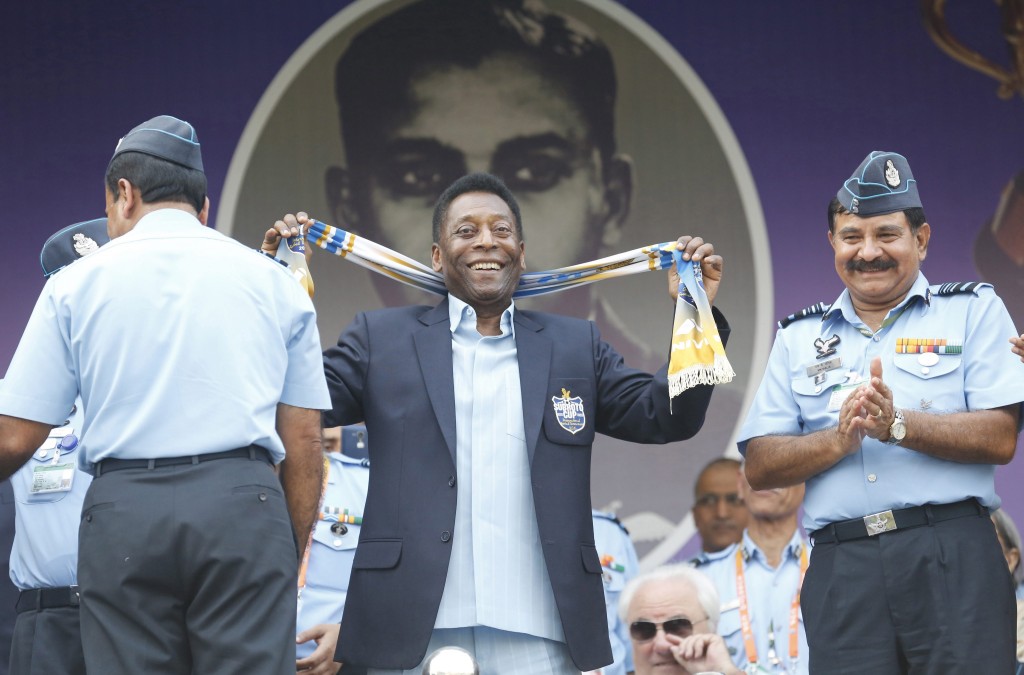In the heart of an eastern Ukrainian city shaken by echoes of guns stands the world’s first shrine to football legend Pele that miraculously survived nearly two years of war.
The creator of the unlikely Lugansk museum — painted in Brazilian gold and green and adorned by a bronze statue of Pele and a giant football at its front door — is a humble 55-year-old balding man who follows his hero’s example by never lighting up a cigarette or drinking alcohol.
“Family, football and Pele. That is my life,” says museum founder Nikolai Khudobin as he sits surrounded by dozens of tributes to the football great.
“I have never even tasted beer because Pele leads a healthy lifestyle. And that is what inspired me,” says Khudobin.
Football’s governing body FIFA recognised Khudobin’s creation as the world’s first museum dedicated to the man widely regarded as the 20th century’s greatest player.
It opened during Ukraine’s co-hosting of the European Championship in 2012 but has been closed for the past two years owing to conflict between Ukraine and pro-Russian separatists.
The Brazilian city of Santos where Pele began his career aged 15 built its own exhibition to its local hero two years later.
“When my museum opened, the Brazilian ambassador hugged me and started crying,” Khudobin recalls.
“He could not believe that, in distant Lugansk, Pele could be so well-loved.”
This place is holy
Even more remarkable is that the museum has managed to withstand the brunt of one of Europe’s most brutal conflicts since the 1990s Balkans wars and which has left nearly 9,200 people dead.
Lugansk is the centre of one of two industrial regions whose main swathes the rebels took over and defended with tanks and powerful multiple-missile launchers.
“The museum has not been open since the war began. Shells kept exploding and flying all over the place. I was really scared that something might smash the museum,” Khudobin admits.
“But I believe that Pele is the god of football and that this place is holy — it is a sanctuary of football.”
The small building was never once hit.
The Beautiful Game
The 75-year-old Pele may be best known to younger fans as a global soccer ambassador with a heart-warming smile.
But to older generations Pele embodies the world’s most popular game — a dazzling entertainer who changed the way football is played while leading his national squad to three breathtaking World Cups between 1958 and 1970.
Pele’s 1281 goals in 1363 matches saw Guinness World Records recognise him as football’s most prolific scorer.
Then Brazilian president Janio Quadros proclaimed him a “national treasure” in 1961.
Unique momentoes to all those achievements line the walls and litter the tables of Khudobin’s two-room museum.
There is an autographed 1958 photo of Pele that went up to Russia’s former space station Mir in the 1980s.
One table displays a golden watch Pele gave former Soviet Union defender Valentin Afonin.
Dozens of stamps and flags are accompanied by a signed banner of Pele and Soviet goalkeeper Lev Yashin — winner of the 1963 Ballon d’Or prize awarded to Europe’s best player.
“I swapped my bicycle for a photo of Pele in a magazine,” Khudobin recalls.
“That was 40 years ago, and I have been collecting ever since.”
Pele saved my life
Khudobin says he not only had the honour to meet Pele on three occasions but also to get a haircut by his idol’s personal barber in Brazil.
But his big dream of bringing Pele to Lugansk was shattered by the sudden outbreak of the lingering war.
A far greater tragedy struck Khudobin when his wife died of natural causes in the midst of the sudden turmoil.
“We went through school together and she always supported my hobby. I still have not recovered from the grief,” Khudobin says.
Another shock came when Khudobin was detained for three days by the city’s new pro-Russian masters.
“I am not a poor man and they wanted to steal my property. They were demanding that I hand over the papers to my apartment.”
Khudobin recalls that at one point his captors put a gun to his head and threatened to shoot him.
“But then they found out who I was and got frightened by all the publicity my death would bring.
“Pele saved my life.”
– by AFP
